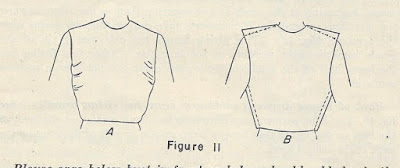Fitting the Bust and Back
The comfort of the waist of a dress depends much on the fit over the bust and across the back. Avoid extremes of fit -- too tight is neither comfortable or attractive; too loose looks untidy. If the wearer has a large bust but small abdomen and hips, fit the dress a little loosely below the bust so the blouse does not outline the bust too closely. Be sure there is enough fullness under the bust in front and enough room for the shoulder blades in the back. The center front and back may be smooth and free from gathers unless the style calls for a different effect. Taking in or releasing darts at the waistline may improve the fit.
Cloth draws across bust. If the dress draws across the bust perhaps the grain of the goods has been dropped or raised on either side of the bust. Or the waist may have been cut too narrow at the bust line. These troubles usually appear when the figure is overly erect or has a large bust.
If the crosswise grain of the goods is straight but still the waist looks drawn, let out the front (or both back and front) underarm seams until the waist fits easily. When the seam allowance is too small to let out underarm seams, set in a straight matched or bias piece of cloth at the underarm seam for extra width. Let out the underarm seams in the sleeves accordingly or if necessary, set in a piece here, too.
If the grain of the goods is not right, rip the underarm seams and try changing the size and position of the underarm darts and the location of the fullness at the waist. If the dress has no underarm dart, and the waist length permits, it may help to place one or more darts in the front edge of the underarm seam in line with the bust.
Diagonal wrinkles from bust line to underarm waistline. The lower front
If the waist of the dress does not reach the waistline in the center front, the pattern must be altered and a new front cut. When there is sufficient length, rip open the underarm and shoulder seams. Let down the center front of the waist by tapering the seam allowance on the front shoulder to 1/4 inch at the neck edge. Then lift the lower waist front with one or more darts at the underarm. (figure 10 B) In addition, more fullness in gathers or darts may be needed under the bust. Let out the front side of the underarm seam. This gives width across the bust and allows additional fullness under the bust. The seam allowance on the back is left unchanged.
An undesirable fold or fullness at armhole in front near chest line. A figure with a prominent shoulder bone and full bust often has a hollow place near the armhole. The dress may puff out there (figure 11 A). This is more prominent if the armhole seam is too high at the armpit. (see future reference)
If the armhole seam allowance is wide enough at the front shoulder line, remove the puff with a front shoulder dart. Pin, baste, and fit again. If the seam allowance is skimpy, rip shoulder and underarm seams. Raise the shoulder in the front more at the armhole, tapering the seam to nothing at the neck (figure 11 B).
The puff can also be removed by the armhole dart in the lower half of the front armhole, extending down as far as possible toward the bust. This gives a close-fitting armhole. Or if the puff is small, sometimes it can be "shrunk" out before setting in the sleeve. Or it can be held in place with a row of small backstitches next to the seam line.
Thoughts? Have you done any of these types of alterations instinctively while making a dress?
Happy Sewing!


No comments:
Post a Comment